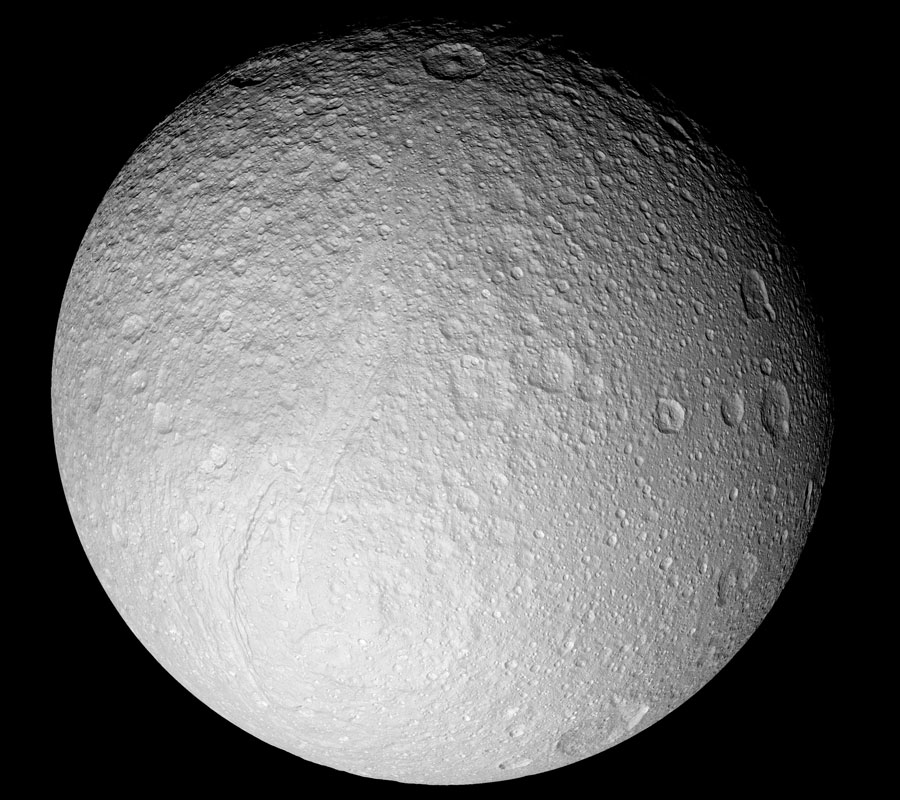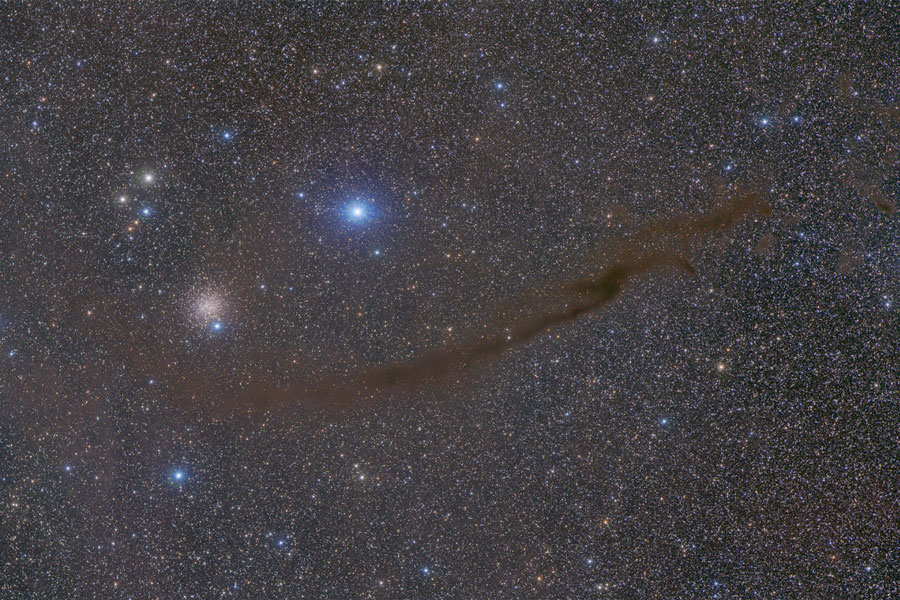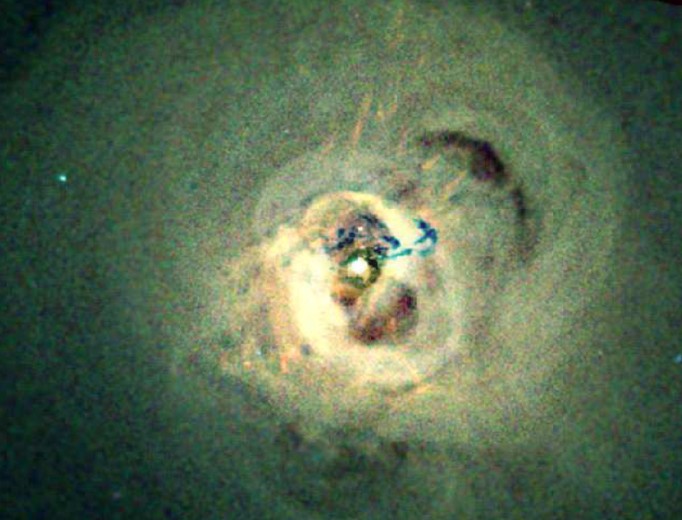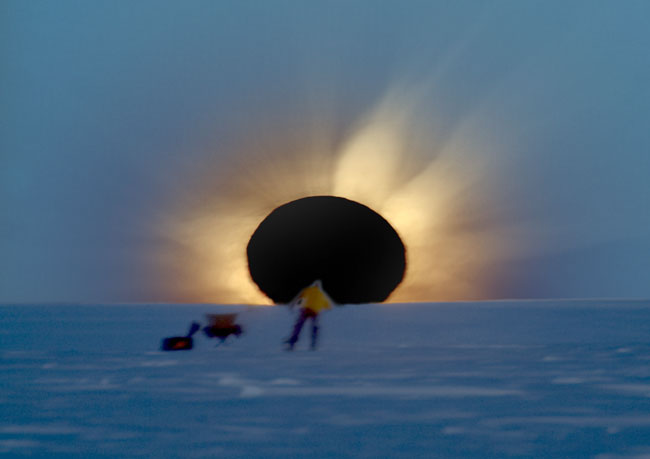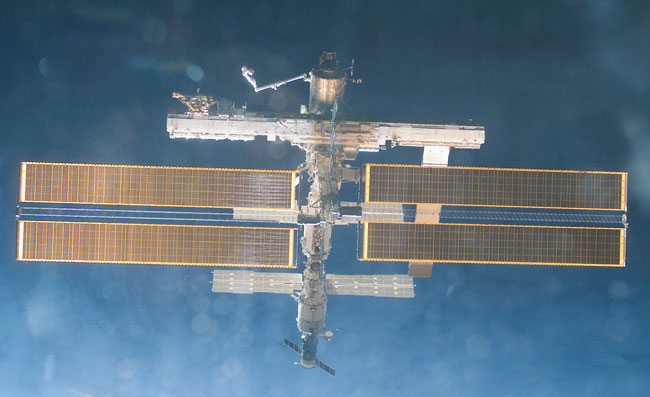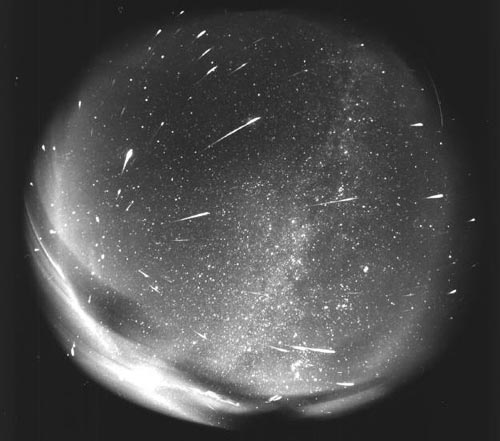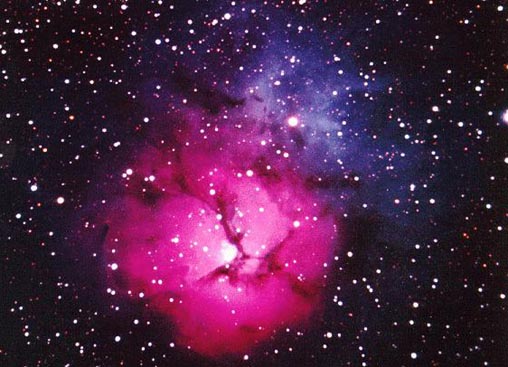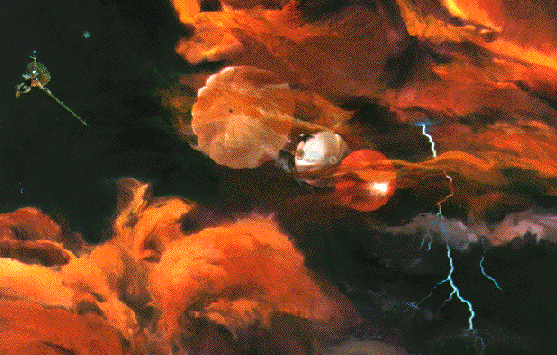| << Previous | Index | Next >> |
2014
Video Credit: Visuals: Erik Wernquist; Music: Christian Sandquist Words & Voice: Carl Sagan
2013 If you could stand on Mars -- what might you see? Scroll right to find out. The robotic Spirit rover that rolled around Mars from 2004 to 2009 Mars climbed to the top of a hill in 2005 and took a series of images over three days that were then digitally combined into a 360 degree panorama. Spirit was instructed to take images having the same resolution as a human with 20-20 eyesight. The full panoramic result can be found by clicking on the above image and has a level of detail unparalleled in the history of Martian surface photography. The panorama was taken from the pinnacle of Husband Hill and has been dubbed the Everest panorama, in honor of the view from the tallest mountain on Earth. Visible in Gusev Crater are rocks, rusting sand, a Martian sundial, vast plains, nearby peaks, faraway peaks, and sand drifts. In the distance, fast moving dust devils can be seen as slight apparitions of red, green, or blue, the colors of filters used to build up this natural color vista.
2012 A Full Moon rises in this waterfront scene. Its colorful, watery reflection is joined by harbor lights and a windowed skyscraper's echo of the western horizon just after sunset. The tantalizing image is a composite of frames recorded at 2 minute intervals on November 28 from the Caspian Sea port city of Baku, Azerbaijan. Still, this Full Moon was not really as big or as bright as others, though it might be hard to tell. In fact, November 28's Full Moon was near apogee, making it the smallest Full Moon of 2012. As it rose over the Baku boardwalk (along with much of the eastern hemisphere), it was also in the Earth's lighter or penumbral shadow. The subtle effect of the penumbral lunar eclipse is just discernible as the slightly darker left side of the lunar disk. Opposite the Sun in planet Earth's sky, the Full Moon was also joined by bright planet Jupiter, only a few days from its own opposition.
2011 The cosmic brush of star formation composed this alluring mix of dust and dark nebulae. Cataloged as Sh2-239 and LDN 1551, the region lies near the southern end of the Taurus molecular cloud complex some 450 light-years distant. Stretching for nearly 3 light-years, the canvas abounds with signs of embedded young stellar objects driving dynamic outflows into the surrounding medium. Included near the center of the frame, a compact, tell-tale red jet of shocked hydrogen gas is near the position of infrared source IRS5, known to be a system of protostars surrounded by dust disks. Just below it are the broader, brighter wings of HH 102, one of the region's many Herbig-Haro objects, nebulosities associated with newly born stars. Estimates indicate that the star forming LDN 1551 region contains a total amount of material equivalent to about 50 times the mass of the Sun.
2010 The robotic rover Opportunity has chanced across another small crater on Mars. Pictured above is Intrepid Crater, a 20-meter across impact basin slightly larger than Nereus Crater that Opportunity chanced across last year. The above image is in approximately true color but horizontally compressed to accommodate a wide angle panorama. Intrepid Crater was named after the lunar module Intrepid that carried Apollo 12 astronauts to Earth's Moon 41 years ago last month. Beyond Intrepid Crater and past long patches of rusty Martian desert lie peaks from the rim of large Endeavour Crater, visible on the horizon. If Opportunity can avoid ridged rocks and soft sand, it may reach Endeavour sometime next year.
2009 What processes formed the unusual surface of Saturn's moon Tethys? To help find out, NASA sent the robotic Cassini spacecraft right past the enigmatic ice moon in 2005. Pictured above is one of the highest resolution images of an entire face of Tethys yet created. The pervasive white color of Tethys is thought to be created by fresh ice particles continually falling onto the moon from Saturn's diffuse E-ring -- particles expelled by Saturn's moon Enceladus. Some of the unusual cratering patterns on Tethys remain less well understood, however. Close inspection of the above image of Tethys' south pole will reveal a great rift running diagonally down from the middle: Ithaca Chasma. A leading theory for the creation of this great canyon is anchored in the tremendous moon-wide surface cracking that likely occurred when Tethys' internal oceans froze. If so, Tethys may once have harbored internal oceans, possibly similar to the underground oceans some hypothesize to exist under the surface of Enceladus today. Might ancient life be frozen down there?
2008 What is that strange dark ribbon on the sky? When observing the great globular cluster NGC 4372, observers frequently take note of a strange dark streak nearly three degrees in length running near it. Unnamed, the streak, actually a long molecular cloud, has become known as the Dark Doodad Nebula. (Doodad is slang for a thingy or a whatchamacallit.) Pictured above in a rich and colorful star-field, the Dark Doodad Nebula can be found sweeping across the image center. The globular star cluster NGC 4372 is visible on the image left, while the bright star gamma Musca is seen to the cluster's right. The Dark Doodad Nebula can be found with strong binoculars toward the southern constellation of the Fly (Musca). The above image was compiled by consecutive 45 minutes exposures taken by a small telescope from the La Frontera region in Chile.
2007 Just fix your camera to a tripod and you too can make an image of graceful trails traced by the stars as planet Earth rotates on its axis. Made on September 14 from Montlaux, France, this wide-angle view nicely shows the stars near the celestial equator tracing nearly straight lines in projection, while stars north and south of the equator, respectively, appear to circle the north and south celestial poles. Featured are the stars of Orion (right of center), brilliant Venus rising (left) as bright star Sirius rises in the south (bottom center), and a polar orbiting Iridium satellite (upper left). Beautiful dawn sky colors seem painted along the horizon. This remarkable picture was constructed from 477 consecutive 30 second digital exposures recorded over 4.3 hours and later combined.
2006
[imghover6=http://apod.nasa.gov/apod/image/0612/NGC2174_lrg720.jpg]http://apod.nasa.gov/apod/image/0612/NG ... lrg720.jpg[/imghover6]Credit & Copyright: Dan Kowall (Photonhunter.com)
2005 The Perseus Cluster of thousands of galaxies, 250 million light-years distant, is one of the most massive objects in the Universe and the brightest galaxy cluster in the x-ray sky. At its core lies the giant cannibal galaxy Perseus A (NGC 1275), accreting matter as gas and galaxies fall into it. This deep Chandra Observatory x-ray image spans about 300,000 light-years across the galaxy cluster core. It shows remarkable details of x-ray emission from the monster galaxy and surrounding hot (30-70 million degrees C) cluster gas. The bright central source is the supermassive black hole at the core of Perseus A itself. Low density regions are seen as dark bubbles or voids, believed to be generated by cyclic outbursts of activity from the central black hole. The activity creates pressure waves - sound waves on a cosmic scale- that ripple through the x-ray hot gas. Dramatically, the blue-green wisps just above centre in the false-color view are likely x-ray shadows of the remains of a small galaxy falling into the burgeoning Perseus A.
2004 What powers the Heart Nebula? The large emission nebula dubbed IC 1805 looks, in whole, like a human heart. The nebula glows brightly in red light emitted by its most prominent element: hydrogen. The red glow and the larger shape are all created by a small group of stars near the nebula's center. A close up spanning about 30 light years contains many of these stars is shown above in a recent image taken by the Canada France Hawaii Telescope. This open cluster of stars contains a few bright stars nearly 50 times the mass of our Sun, many dim stars only a fraction of the mass of our Sun, and an absent microquasar that was expelled millions of years ago. The Heart Nebula is located about 7,500 light years away toward the constellation of Cassiopeia.
2003 The Sun, the Moon, and two photographers all lined up last month in Antarctica during an unusual total eclipse of the Sun. Even given the extreme location, a group of enthusiastic eclipse chasers ventured near the bottom of the world to experience the surreal momentary disappearance of the Sun behind the Moon. One of the treasures collected was the above picture -- a composite of four separate images digitally combined to realistically simulate how the adaptive human eye saw the eclipse. As the image was taken, both the Moon and the Sun peaked together over an Antarctic ridge. In the sudden darkness, the magnificent corona of the Sun became visible around the Moon. Quite by accident, another photographer was caught in one of the images checking his video camera. Visible to his left are an equipment bag and a collapsible chair.
2002 The developing International Space Station (ISS) has changed its appearance yet again. Earlier this month the Space Shuttle Endeavor visited the ISS and installed the fourth of eleven pieces that will compose the Integrated Truss Structure. The new P-1 Truss is visible on the left, below the extended solar panels. The world's foremost space outpost can be seen developing over the past few years by comparing the above image to past images. Also visible above are many different types of modules, a robotic arm, several wing-like solar panels, and a supply ship. Construction began on the ISS in 1998 and the core structure should be in place before 2005.
2001 Craters produced by ancient impacts on the airless Moon have long been a familiar sight. But only since 1999 have observers seen elusive optical flashes on the lunar surface - likely explosions resulting from impacting meteoroids. These startling observations were made with modest telescopes and video equipment during the 1999 and 2001 Leonid meteor showers. Six confirmed flashes, some initially as bright as a third magnitude star, were all seen within hours of the peak of the 1999 shower. At least two more lunar flashes, the brightest one at about fourth magnitude, have been confirmed during this November's Leonid storm. The 1999 locations are indicated by the red Xs on the dark lunar night side in this projection of the Moon from November 18 of that year. Similar flashes would have been difficult to see if viewed against the Moon's brightly lit portion. It is estimated that the flashes were made by meteoroids with masses in the range of 1 to 10 kilograms, producing craters a few meters across.
2000 Throughout the Universe, galaxies tend to swarm in groups ranging from just a handful of members to casts of thousands. Astronomers have realized since the early 1970s that the larger swarms, immense clusters of galaxies millions of light-years across, are immersed within tenuous clouds of hot gas which glow strongly in x-rays. These clouds may have been heated by their collapse in the early Universe, but in many galaxy clusters, the gas appears to be cooling. This Chandra Observatory x-ray image reveals a striking cooling flow in the central regions of the galaxy cluster cataloged as Abell 1795. Brighter pixels in the false-color image represent higher x-ray intensities. The bright filament down the center indicates gas condensing and cooling -- rapidly loosing energy by radiating x-rays. At the very top of the filament is a large, x-ray bright galaxy. As it moved through the cluster gas cloud, the massive galaxy's gravitational influence seems to have created this cosmic wake of denser, cooling gas. Continuing to cool, the cluster gas will ultimately provide raw material to form future generations of stars.
1999 Craters produced by ancient impacts on the airless Moon have long been a familiar sight. But now observers have seen elusive optical flashes on the lunar surface - likely the fleeting result of impacting meteoroids. Orchestrated by David Dunham, president of the International Occultation Timing Association (IOTA), video recordings made with modest equipment and visual telescopic observations have, for the first time, detected and confirmed a total of six flashes on the Moon's dark side. The flashes, some initially as bright as a third magnitude star, were all seen within hours of the peak of this year's Leonid meteor shower. Their locations are indicated by the red Xs on this projection of the Moon as it appeared on the night of November 18. Similar flashes would have been difficult to see if viewed against the Moon's brightly lit portion. It has been estimated that the brightest flashes were made by meteoroids weighing around a tenth of a kilogram, resulting in lunar craters about one meter across. And ... the next chance to observe lunar impact flashes is coming up! Enterprising astronomers interested in long distance lunar prospecting should be monitoring the dark side of a nearly first quarter Moon during the Geminids meteor shower which will peak around December 13.
1998 Is Leo leaking? Leo, the famous sky constellation visible on the left of the above all-sky photograph, appears to be the source of all the meteors seen in this year's Leonids Meteor Shower. That Leonids point back to Leo is not a surprise - it is the reason this November meteor shower is called the Leonids. Sand-sized debris expelled from Comet Tempel-Tuttle follows a well-defined orbit about our Sun, and the part of the orbit that approaches Earth is superposed in front of the constellation Leo. Therefore, when Earth crosses this orbit, the radiant point of falling debris appears in Leo. Over 150 meteors can be seen in the above four-hour exposure. The Geminid Meteor Shower, which appears to eminate from the constellation of Gemini, peaks this coming weekend.
1997 Three dark dust lanes give the picturesque Trifid Nebula its name. The red and blue colors of the Trifid Nebula are present in different regions and are created by different processes. A big bright star near the center of the red region appears white hot and emits light so energetic it knocks electrons away from gas surrounding it. When an electron is recaptured by a proton, red light is frequently emitted. The blue region is centered on another bright star but this region's dust reflects light to us. The two regions are thus called an emission nebula and reflection nebula, respectively. The Trifid Nebula can be seen in Sagittarius toward the Galactic Center with a small telescope.
1996 Like the Earth's Moon, Mercury is scarred with craters, testifying to an intense bombardment during the early history of the Solar System. In 1974, the Mariner 10 spacecraft surveyed this innermost planet up close, producing the only detailed images of its tortured surface. In the above mosaic the bright rays emanating from the 27 mile wide Degas crater almost appear to be painted on. The rays consist of light colored material blasted out during the crater's formation. Numerous smaller, younger craters are seen superposed on the Degas crater itself.
1995 Hours ago, at about 5:00 pm EST (2200 GMT) December 7, Galileo's descent probe slammed into Jupiter's atmosphere. Above is an artist's vision of the probe's planned descent from a dramatic perspective. The protective aeroshell, still glowing from the fiery entry, is seen falling away, the 8 foot parachute has deployed, and the orbiter (upper left) is visible high above the cloud tops listening intently to the probe's data transmissions. As illustrated the probe may have encountered lightning, or at lower levels even water rain. Ultimately, the probe was expected to be vaporized by the intense heat deep below the clouds. NASA controllers have received telemetry signals from the orbiter indicating that it has recorded the probe's transmissions and has subsequently successfully fired its rocket engine entering orbit around Jupiter. The first playback of the recorded data to ground stations on Earth is scheduled for December 10-13. Congratulations to the Galileo Team!
| << Previous | Index | Next >> |




